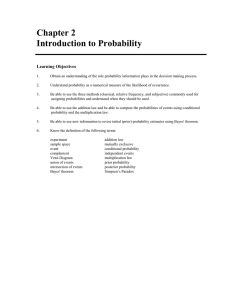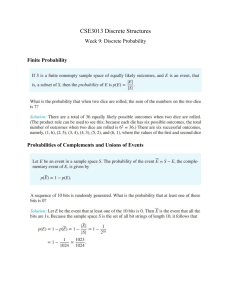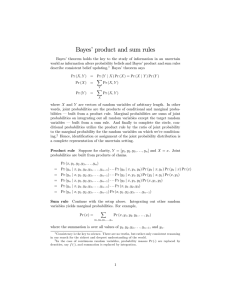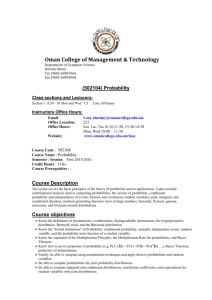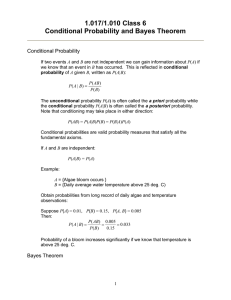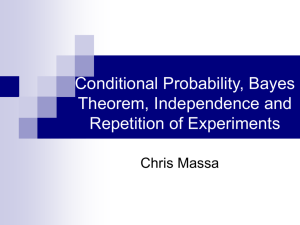Review sheet
advertisement
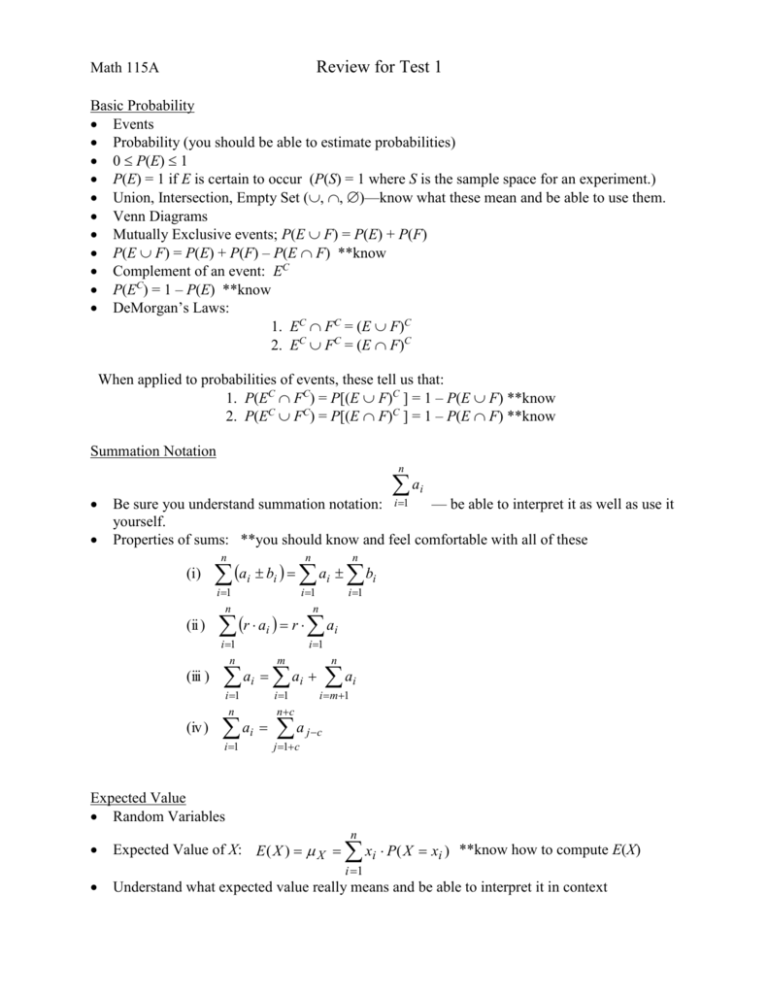
Review for Test 1 Math 115A Basic Probability Events Probability (you should be able to estimate probabilities) 0 P(E) 1 P(E) = 1 if E is certain to occur (P(S) = 1 where S is the sample space for an experiment.) Union, Intersection, Empty Set (, , )—know what these mean and be able to use them. Venn Diagrams Mutually Exclusive events; P(E F) = P(E) + P(F) P(E F) = P(E) + P(F) – P(E F) **know Complement of an event: EC P(EC) = 1 – P(E) **know DeMorgan’s Laws: 1. EC FC = (E F)C 2. EC FC = (E F)C When applied to probabilities of events, these tell us that: 1. P(EC FC) = P[(E F)C ] = 1 – P(E F) **know 2. P(EC FC) = P[(E F)C ] = 1 – P(E F) **know Summation Notation n ai Be sure you understand summation notation: i 1 — be able to interpret it as well as use it yourself. Properties of sums: **you should know and feel comfortable with all of these (i) (ii ) n n n i 1 n i 1 n i 1 ai bi ai bi r ai r ai i 1 n (iii ) i 1 n (iv ) i 1 ai m n ai i 1 nc ai i m1 a i a j c i 1 j 1c Expected Value Random Variables n xi P ( X xi ) Expected Value of X: E ( X ) X Understand what expected value really means and be able to interpret it in context **know how to compute E(X) i 1 Conditional Probability P( E F ) P( E | F ) , assuming P( F ) 0 or P( E F ) P( E | F ) P( F ) P( F | E ) P( E ) P( F ) **know . Remember that these formulas can be used for finding P(E F) if we already know the other probabilities. Independent events: you should have a practical understanding of what it means for two events to be independent (or dependent). You should also be able to show mathematically that two events are independent (or dependent): e.g. If P(E|F) = P(E), then E and F are independent. How else might you show this mathematically? Bayes’ Theorem P( A) n P( A | Bi ) P( Bi ) ***this formula will be given. i 1 Recall that Bayes’ Theorem allows us to find “backwards” conditional probabilities. There are two approaches you may take to Bayes’ Theorem: you may focus on using the formula or you may use tree diagrams (like we did in class) instead. Regardless, you must be able to find any conditional probability. P( A | Bk ) P( Bk ) ***I will give you this one, too. Bayes' Formula : P( B k | A) n P ( A | Bi ) P ( Bi ) i 1 Project I will not yet ask specific questions about the project—these will be asked in the project 1 quiz. At that time, you should understand the point of our project, what the foreclosure and default values mean, etc. I may ask you about details of your borrower’s background and about computations you made to solve the project. Computer stuff Know the basics: how to compute a sum using Excel; what CountIf, DCount, DAverage are used for and how to use them. I will not ask you where a particular function can be found within Excel. Miscellaneous In any “word problems”, you should be able to interpret calculations you perform in the context of the problem. For example: What does P(A|B) represent if A is the event that you buy a new boat and B is the event that you get a raise at work? You should be able to determine whether or not most of your answers seem reasonable. I may not ask you this specifically, but it will certainly help you identify some possible errors, like probabilities >1, etc. In any short-answer test questions where there is work for you to show, make sure you show it! If you can’t think of work to show, then explain your thought process in solving the problem. For any multiple-choice type problems, there is no need to show work (they will be graded right/wrong.)

